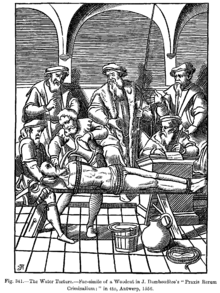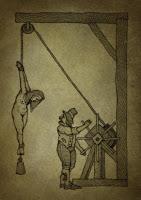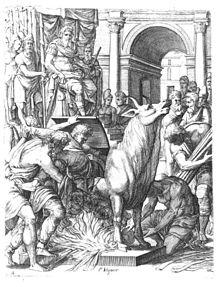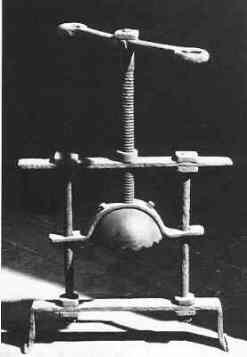10. Schwedentrunk
The Schwedentrunk (English: Swedish drink) is a method of torture and execution. The name was invented by German victims of Swedish troops during the Thirty Years' War. They lay the bound servant on the ground, stuck a wooden wedge into his mouth, and poured into his belly a bucket full of foul manure water, which they called a Swedish Drink.”Use of the Schwedentrunk is recorded in the histories of towns throughout Southern Germany. Though specific circumstances differed, in every case a restrained and gagged victim was forced to swallow (by means of a funnel) a large amount of unappetizing, sometimes boiling liquid. Substances such as urine, excrement, liquid manure, and sullage were used for this purpose.Apart from disgust, illness, and the possibility of bacterial infection, the Schwedentrunk inflicted intense gastric pain. Because liquids are incompressible, the victim's stomach and bowels must expand to painful proportions to accommodate the copious quantities of fluid. The torturers then squeezed the distended belly with wooden boards or trampled the victim underfoot.
9. Alfet
An alfet (Old English: ālfæt, "fire vat") was an ancient cauldron filled with boiling water, into which an accused person was to plunge his arm up to his elbow. The arm and hand were then bound and left for three days. If the wound was found to have begun to heal cleanly the person was judged to be innocent. However, if the scald was infected or unhealed, the victim was held to be guilty. It was also used for purgation. 8. Strappado
8. Strappado
The Strappado is a form of torture in which the victim's hands are first tied behind his or her back and suspended in the air by means of a rope attached to wrists, which most likely dislocates both arms. Weights may be added to the body to intensify the effect and increase the pain.Other names for strappado include "reverse hanging" and "Palestinian hanging" (although it is not used by the Palestinian Authority). Historically, it was used by the medieval Inquisition and many governments.
7. Scaphism
Scaphism, also known as the boats, was an ancient Persian method of execution designed to inflict torturous death that was described by the Persians' archenemies, the Greeks.The intended victim was stripped naked and then firmly fastened within the interior space of two narrow rowing boats (or hollowed-out tree trunks) joined together one on top of the other with the head, hands and feet protruding. The condemned was forced to ingest milk and honey, and more honey would be poured on him to attract insects, with special attention devoted to the eyes, ears, mouth, face, genitals, and anus. In some cases, the executioner would mix milk and honey and pour that mixture all over the victim. He would then be left to float on a stagnant pond or be exposed to the sun. The defenseless individual's feces accumulated within the container, attracting more insects which would eat and breed within the victim's exposed flesh, which—pursuant to interruption of the blood supply by burrowing insects—became increasingly gangrenous.
The individual would lie naked, covered from head to toe in milk, honey, and his own feces. The feeding would be repeated each day in some cases to prolong the torture, so that fatal dehydration or starvation did not occur. Death, when it eventually occurred, was probably due to a combination of dehydration, starvation, and septic shock. Delirium would typically set in after a few days.
6. Zánzhǐ
Zánzhǐ is one technique of torture that was used in ancient China. For interrogation of female suspects without threatening life or limb, zánzhǐ was generally applied. It consisted of a set of six wooden sticks positioned around and between the fingers and connected by strings. Each time the prisoner refused to testify or confess, the string was pulled, slowly, agonisingly squeezing the fingers between the sticks until their bones were crushed. The Soviet KGB used a variant of this for crushing fingers or toes. The kia quen, a similar device applied exclusively to men, was used to crush the feet or ankles.5. Rack
The rack is a torture device consisting of a rectangular, usually wooden frame, slightly raised from the ground, with a roller at one or both ends. The victim's ankles are fastened to one roller and the wrists are chained to the other. As the interrogation progresses, a handle and ratchet mechanism attached to the top roller are used to very gradually increase the tension on the chains, inducing excruciating pain. By means of pulleys and levers this roller could be rotated on its own axis, thus straining the ropes until the sufferer's joints were dislocated and eventually separated. Additionally, if muscle fibres are stretched excessively, they lose their ability to contract, rendering them ineffective.One gruesome aspect of being stretched too far on the rack is the loud popping noises made by snapping cartilage, ligaments or bones. One powerful method for putting pressure upon prisoners was to force them to watch someone else being subjected to the rack. Confining the prisoner on the rack enabled further tortures to be simultaneously applied, typically including burning the flanks with hot torches or candles or using pincers made with specially roughened grips to tear out the nails of the fingers and toes. Usually, the victim's shoulders and hips would be separated and their elbows, knees, wrists, and ankles would be dislocated.4. Instep borer
The instep borer was a medieval German instrument of torture that externally resembled an iron boot. It was hinged to permit the free insertion and removal of the bare foot. A crank projected from a housing over the instep, which concealed a long, thick, serrated iron blade, grooved so as to inflict maximum damage and promote liberal blood flow.Turning the crank slowly advanced the blade into the boot, punching a hole through the center of the instep. The resultant wound was so large that it was not unusual for the prisoner to die of toxemia soon after.The fact that this device is recorded only in leads to the conclusion that it was only in use at Nuremberg. It is troubling, though, that the catalog which Hirsch purports to document makes no reference whatsoever to the instep borer among its thousand-plus catalogued items, leading to the possibility that the instep borer may have existed only in fantasy.3. Knee Splitter
The knee splitter was a form of torture used mainly during the inquisition. It’s said that this device was a uniquely German device, first recorded in 1530;also going by the names Kranz or Schneiden. It was created from two spiked wood blocks, placed in front of, and behind the knee. The blocks were connected with two large screws. When turned, the blocks would close towards each other, destroying the knee underneath them. This method was used to render the knees useless. The number of spikes on the blocks would range from three to twenty, depending on the captive. To make the pain more unbearable, the torture master would sometimes amuse himself by tapping on the metal cap with a small hammer. 2. Brazen Bull
2. Brazen Bull
The brazen bull, bronze bull, or Sicilian bull, was a torture and execution device designed in ancient Greece. According to Diodorus Siculus, recounting the story in Bibliotheca historica, Perillos of Athens invented and proposed it to Phalaris, the tyrant of Akragas, Sicily, as a new means of executing criminals. The bull was made entirely of bronze, hollow, with a door in one side. The bull was in the form and size of an actual bull and had an acoustic apparatus that converted screams into the sound of a bull. The condemned were locked in the device, and a fire was set under it, heating the metal until the person inside roasted to death.
1. Head Crusher



